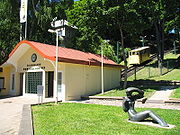
Žaliakalnis Funicular Railway
Encyclopedia


Kaunas
Kaunas is the second-largest city in Lithuania and has historically been a leading centre of Lithuanian economic, academic, and cultural life. Kaunas was the biggest city and the center of a powiat in Trakai Voivodeship of the Grand Duchy of Lithuania since 1413. During Russian Empire occupation...
, Lithuania
Lithuania
Lithuania , officially the Republic of Lithuania is a country in Northern Europe, the biggest of the three Baltic states. It is situated along the southeastern shore of the Baltic Sea, whereby to the west lie Sweden and Denmark...
. Built in 1931, it is the oldest funicular in Lithuania. The funicular is made of a wood-paneled coachwork and is serviced by a uniformed, English-speaking operator. The climb of 142 metres (465.9 ft) up from behind the Vytautas the Great War Museum
Vytautas the Great War Museum
The Vytautas the Great War Museum is a museum in Kaunas, Lithuania. It was opened on 16 February 1936 and named after Vytautas the Great, Grand Duke of Lithuania. The museum displays historical artefacts pertaining to Lithuania and Kaunas from prehistoric times to the present day, including a...
to the Church of the Resurrection
Christ's Resurrection Church, Kaunas
Christ's Resurrection Church is a monumental Roman Catholic church in Kaunas, Lithuania. The church was consecrated in 2004, and in 2005 it was finally completed.-History:...
offers some of the best views in Kaunas. The ticket costs 0.5 litas.
It was constructed by the engineering office Curt Rudolph Transportanlagen from Dresden
Dresden
Dresden is the capital city of the Free State of Saxony in Germany. It is situated in a valley on the River Elbe, near the Czech border. The Dresden conurbation is part of the Saxon Triangle metropolitan area....
, Germany
Germany
Germany , officially the Federal Republic of Germany , is a federal parliamentary republic in Europe. The country consists of 16 states while the capital and largest city is Berlin. Germany covers an area of 357,021 km2 and has a largely temperate seasonal climate...
with electrical equipment from AEG
AEG
Allgemeine Elektricitäts-Gesellschaft was a German producer of electrical equipment founded in 1883 by Emil Rathenau....
and mechanical parts from Bell Maschinenfabrik, Switzerland
Switzerland
Switzerland name of one of the Swiss cantons. ; ; ; or ), in its full name the Swiss Confederation , is a federal republic consisting of 26 cantons, with Bern as the seat of the federal authorities. The country is situated in Western Europe,Or Central Europe depending on the definition....
. The official opening was on 5 August 1931 with one passenger car, while the second car was only a platform ballasted with stones used to counterbalance the passenger car. The electric overhead power cable and the pantographs
Pantograph (rail)
A pantograph for rail lines is a hinged electric-rod device that collects electric current from overhead lines for electric trains or trams. The pantograph typically connects to a one-wire line, with the track acting as the ground wire...
of the coaches are only used for lighting and heating of the cars. The upper station housed the electrically driven funicular mechanism in the basement, whilst the lower end of the line did not even have a shelter till 1932.
The funicular was renovated between 1935 and 1937. New larger cars with car bodies from Napoleonas Dobkevičius on underframes from Bell Maschinenfabrik were built and the lower station was given a proper building.
The Žaliakalnis Funicular Railway was included into the Registry of Immovable Cultural Heritage Sites of the Republic of Lithuania in 1993.

